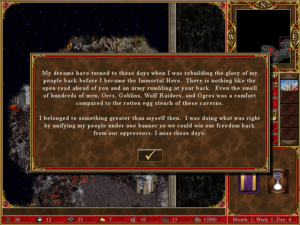Heroes Chronicles: Masters of the Elements
So, on into Tarnum’s third adventure. The story so far: In Warlords of the Wasteland, Tarnum was a Barbarian in a land conquered and enslaved by evil wizards. He led a successful rebellion, then became a conquerer and enslaver himself, slaughtering his own people when he considered them counterrevolutionary, murdering his advisers when they told him he was going too far. Episode 1 ended with his star still in the ascendant, but when you’re the best gunslinger in town, everyone starts gunning for you, and it’s only a matter of time before one of them gets lucky. And so somewhere between episodes 1 and 2, Tarnum went and got himself killed.
But instead of just going to Hell like you’d expect, he somehow wound up staying in the mortal world as a servant of the “Ancestors”, apparently working off his bad karma. At least, until Episode 2, Conquest of the Underworld, which had him actually invading Hell, but not to take up permanent residence. He was there on a mission to rescue the abducted soul of one Rion Gryphonheart, the former king of the Knights who took over after Tarnum’s Barbarian empire fell — and the person who killed Tarnum in battle. Tarnum didn’t much like the idea of helping his mortal enemies, and considered the possibility that it was all some kind of immense joke at his expense on the part of the Ancestors, but it turned out that they chose him for the task to teach him a lesson, that the Knights and the Barbarians aren’t so different, that in fact he should be calling them family.
Masters of the Elements takes this a step further. One of the defining properties of the Heroes Chronicles series is that each episode focuses on a different subset of the various playable sides from Heroes of Might and Magic, giving Tarnum himself a different character class from episode to episode. This time around, he’s a Wizard. The one thing he despises the most. The thing he led a continent-spanning crusade to wipe out during his mortal life. I’m only a little way into the story, but he’s already made plenty of disparaging comments (via triggered text pop-ups) about the people he’s forced to work with here. I think he’s already gradually coming to appreciate their point of view, though. The entire mission here would be impossible without magic.
The essential idea is that a ten-thousand-year truce between the Ancestors and the Elemental Lords is ending, and rather than wait for them to attack the prime material plane, Tarnum is heading to their home turf to forcibly convince them that renewing the truce is in their best interests. The whole idea of visiting the Elemental Planes, similar to the Underworld back in episode 2, is essentially just a coat of paint on standard HOMM3-engine dungeons, but those dungeons are themselves essentially just a texture swap on the above-ground bits, so I suppose it all evens out.
The differences between Barbarian, Knight, and Wizard, on the other hand, have distinct gameplay effects. It’s been a while since I played any of the other classes, but nonetheless, I’m getting a very strong sense that using spells in combat is a more viable and indeed essential option than previously. Also, playing with the types of creatures generated by wizard towers gives you access to some very powerful ranged attacks. Every type of town has some kind of low-level unit, like gobins or imps or skeletons, that can be produced very cheaply or picked up for free from outbuildings, and that you can wind up with hundreds of in a stack. The low-level unit for Towers is the gremlin, which can be upgraded (still pretty cheaply) into the master gremlin, which is, I think, unique among the cheapo creatures for having a ranged attack. They die by the dozens if the enemy can close with them, but the ranged attacks are pretty good at preventing this from happening. It’s the “glass cannon” approach, traditional role of wizard-types since D&D.
 Comments(0)
Comments(0)

